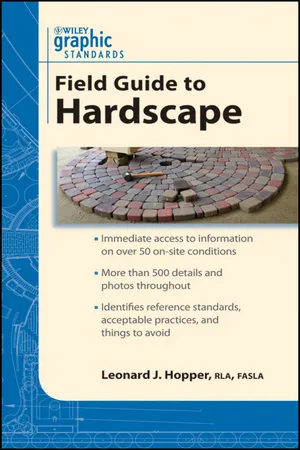
- English
- ePUB (mobile friendly)
- Available on iOS & Android
Graphic Standards Field Guide to Hardscape
About This Book
Quick, reliable answers to your most common on-site questions
When you're in the field, you never know what you'll come across. The Graphic Standards Field Guide to Hardscape gives you fast access to the practical information you need when you're on-site and under pressure.
Presented in a highly visual and easily portable format, the Field Guide is organized to follow a logical project sequence from site evaluation of existing conditions through construction maintenance. Covering everything from assessing existing conditions, site work, bases and paving, site improvements, and materials, this handy companion conveys the most common answers that landscape architects need in the real world when visiting a construction site, and meeting with architects and engineers or clients and contractors.
The Field Guide to Hardscape extends the familiar Landscape Architectural Graphic Standards beyond the office or studio with:
-
Quick access to essential information when away from the studio
-
Things to look for when assessing existing conditions during preliminary design site visits or pre-construction meetings
-
Graphic Standards—quality details accompanied by real-world photographs of best construction practices and techniques
-
Illustrations that help you troubleshoot problems, along with on-the-spot solutions
-
A list of common construction mistakes and problems to avoid
-
Compact format that's easy to reference and carry along
The Graphic Standards Field Guide to Hardscape is the ideal companion for the on-the-go landscape architect, design professional, inspector, facilities manager or anyone that is involved with site construction.
Frequently asked questions
Information
- Site Inventory and Observations
- Photographic Information
- Document and evaluate the condition of existing context and site features as part of the development of a base plan.
- Provide a basis for the development of the site's opportunities and constraints.
- Observe and document any social or cultural factors that should be considered during the design development phase.
- Provide up-to-date site information in order to prepare accurate contract documents.
- Cigarette butts around a bench;
- A short-cut path worn across a lawn;
- Raised gardening beds full of weeds.
- Locate on a site plan the exact location of each user
- Number each of the located users
- Record against numbers in a field notebook the age, gender, and activity of each user
- Add arrows to indicate movement. Circle designated users to indicate people in a group
- An example of a multiple-choice question is: “Do you come here more than once a day/once a day/once every few days/about once a week/less often?” You check the appropriate box corresponding to the response on the interview form; data is quantitative.
- An open-ended question might ask, “How do you feel after spending time in the garden?” Write down all that the respondent says. This provides richer, more qualitative answers.
- Avoid rushing through a site visit. Well spent time during a site visit is always better than having to make repeat visits to gather information that could be gathered in a single, comprehensive site visit.
- Avoid scheduling too little time for a site visit. Often, a good deal of information can be gathered about how a site is being used, by just spending some time there and observing what takes place during the course of a day.
- Avoid making quick judgments about how a site is used based on one limited visit.

- A documentation of existing conditions prior to the start of construction.
- A good reference during the preparation of contract documents that can minimize additional site visits.
- Help respond to requests for information from contractors during the bidding process.
- Help respond to questions during the construction process.
- Confirm construction practices and document conformance or deviations with the contract documents.
- Resolve disputes and provide accountability, such as whether damage to existing site elements to remain occurred during the construction process.
- Documentation of how site elements have been constructed as well as underground utilities that will not be visible after the project has been completed.
- Provide before and after pictures of the project. After a project is completed, it is very easy to quickly forget how the site looked prior to the project being undertaken.


Table of contents
- Cover
- Title Page
- Series
- Copyright
- Introduction
- Part I: Existing Conditions
- Part II: Temporary Construction Installations
- Part III: Demolition and Site Clearing
- Part IV: Earthwork
- Part V: Exterior Improvements